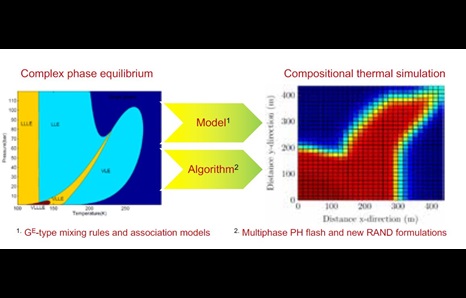Heavy oil reservoirs undergo large changes in temperature and pressure depending on the applied production strategy. The project presents tools for thermal simulation.
Of the total known world oil reserves only 30 % are conventional sources, while 70 % are heavy oil, extra heavy oil, oil sands and bitumen. Presently, the cost of producing heavy oil is often close to the sale price of the oil. Therefore, the cost of production needs to come down. To that end, better understanding of the production processes is required. The focus of the project is thermodynamic description of the oil.
Heavy oil is a viscous and dense substance, which flows very slowly under gravity at atmospheric temperature. Most often it is necessary to use steam to reduce the viscosity and enhance oil production. Production can be further enhanced with a light hydrocarbon solvent.
Simulation of heavy oil reservoirs is not trivial, as they undergo large changes in temperature and pressure depending on the applied production strategy. Furthermore, the use of a light hydrocarbon solvent can lead to highly asymmetric mixtures and the appearance of a second oleic phase.
A number of possible equations of state (EoS’s) were evaluated. It was found, that if the interaction between the water and hydrocarbon phases is not considered important, then the commonly used cubic EoS’s with the van der Waals mixing rules are suitable. If more complex interactions are considered important, then the cubic EoS’s can be used with the Huron-Vidal type mixing rules. More complex EoS’s such as cubic plus association (CPA) or PC-SAFT can also be used.
For thermal simulation it is necessary to add an energy balance to the system. Commonly, the temperature is used as an additional primary variable. The resulting isothermal flash specification can lead to some problems during transient simulation. The fluid in some grid-blocks may become narrow boiling. The enthalpy of a narrow boiling mixture changes rapidly due to very small changes in temperature or pressure.
An approach using the energy directly in the flash calculation (e.g. isobaric, isenthalpic flash) is explored in this work and an algorithm presented which takes only slightly more computational resources than the conventionally used isothermal flash. This is demonstrated to be robust for a number of mixtures, and an approach tailored for the flash calculation of mixtures containing water is described.
The conventional isothermal flash framework is cumbersome when dealing with more than two or three phases. A new method – modified RAND – is presented. The method is primarily examined for multiphase isothermal flash, with a robust implementation described. Furthermore, the conventional method of solving an EoS at a specified temperature and pressure is abandoned and a method which co-solves the EoS with the equilibrium equations is described – vol-RAND.
Finally, a thermal EoS based reservoir model is developed from an isothermal simulator. The energy balance partial differential equation is added, and the temperature used as an additional primary variable. The EoS’s compared for heavy oil related fluids are implemented in the simulator. Also, a multiphase flash algorithm using modified RAND and stability analysis skipping is added to the simulator.
With the thermal reservoir simulation tool developed it is possible to carry out further comparisons and add more complexity in future work.

Illustration:
Handling complex equilibrium in compositional simulation through advanced thermdynamic models and efficient equilibrium calculation algorithms: The RAND-based formulations provide a new framework for multiphase flash w/ or w/o reactions.